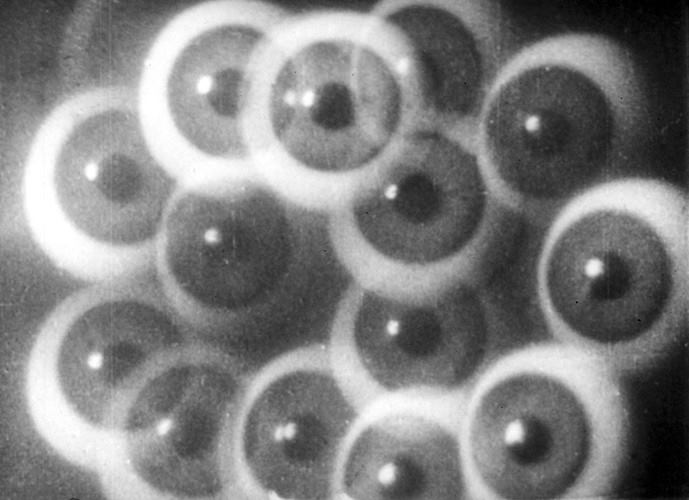
- This event has passed.
Archivi Mario Franco – Cinema Assoluto o Astratto 3° INCONTRO
20 March 2019

March 20th 2019
STARTING PROJECTIONS at 6:00 p.m.
Mario Franco Archives c/o Casa Morra Archives of Contemporary Art
Salita San Raffaele 20/C, Naples
3RD MEETING
Viking Eggeling
DIAGONAL SYMPHONIE (1923-24/25)
Dir.: Viking Eggeling; 35mm, 7’50”;restored by Svenska Filminstitutet / Cinemateket.
A mythical film that confirms the extraordinary design of Eggeling’s work, which reproduced the musical scansion of a “sonata” in the controlled abstraction of more than 7000 drawings. A work that is even paradoxical for its rigor and formal coherence, which remains unique and unrepeatable, also due to the death, almost contemporary to the first screening, of the author who was unable to continue his research.
Hans Richter
RHYTHMUS 21 (1921?/25)
Dir.: Hans Richter; 35mm, 65m, 3’30” (16 fps), Münchner Stadtmuseum / Filmmuseum.
Richter explores the dynamic transformation of signs in time, a harmonic time that can be linked to musical expression (Richter was, among other things, a friend of Ferruccio Busoni). And if in these first experiments he films, with the technique of carton decoupé animation, abstract figures, pure and regular: “the rhythm, or rather the articulation of the units of time, constitutes the sensation par excellence that can provoke any expression of movement in the art of cinema”.
FILMSTUDIE (1926)
Dir.: Hans Richter; ph.: Hans Richter, Endrejat; music: score from “La Création du monde” by Darius Milhaud; 6′ (16 fps), Nederlands Filmmuseum.
Richter approaches the Surrealist theme in this film based, by his own admission, on a dream, and which represents the expressive-technological means of verifying the reliability of the passage between graphic abstraction and its formal and rhythmic equivalent derived from re-elaborations of reality.
Oskar Fischinger
STUDIES NR. 5 in jazz (1929)
Project for a live musical synchronization. The simple, essential strokes, sketched in charcoal and then presented in the further fascinating indistinctness of the negative, are formed, grouped, and pulsate.
EIN FORMSPIEL / [A FORM-PLAY] (1927)
Dir.: Oskar Fischinger; 35mm, color, 6’10” Deutsches Filmmuseum.
One of Fischinger’s experiments in the pre-sound era, to be sonorized in performances by musicians with a multimedia effect, as we would say today. The fascination of abstraction in constant mutation, with many specular passages, with the pulsating and continuous explosion of regular figures in evolution. Part of the material here colored with the classic systems of silent, will become the experimentation of the system Gasparcolor.
MÜNCHEN-BERLIN WANDERUNG [Journey from Munich to Berlin] (1927)
Dir., ph.: Oskar Fischinger; 16mm, 4′ (18 fps), Deutsches Filmmuseum.
Jumping images of faces, bodies, animals, clouds, landscapes, burnt frames, memories of his journey between the two cities, which in the concrete abstraction typical only of cinema, evoke the representation of the process of memory. Fischinger uses the single-frame technique, as will later be done by the most important filmmaker of the American underground, Jonas Mekas.
Man Ray
LE RETOUR A LA RAISON (1923)
In this film the American artist, who had just moved to Paris, uses the technique of rayography (contact photography) of which he was the pioneer. We see on the screen of everyday objects such as springs, nails, night lighting, the writing “dancer” with cigarette smoke, light and shadow on the wall and finally the naked breast of Kiki de Montparnasse, muse-model in many works of Man Ray.
EMAK BAKIA a cinépoéme [Leave Me Alone] (1926)
With Kiki de Montparnasse and Jacques Rigaut
A long series of images according to the incongruous surrealist juxtaposition, rayograms and rotating optical effects: lights, flowers, nails. Wooden constructions and cardboard silhouettes that mimic human movement. A woman in a car drives along country roads. Farm animals. She gets out of the car and dances to the sound of a gramophone: dancing legs, sea, swimming fish, geometric shapes, cut glass. A man removes his starched collar. A girl has flashily painted eyes. When she opens her eyelids, we discover her real eyes.
Fernand Léger
LE BALLET MECANIQUE (1924)
D. Fernand Léger, Dudley Murphy; photography: Dudley Murphy, Man Ray; music: Georges Antheil.
George Antheil, a desecrating and original musician dictates the rhythm of the film. The disjointed silhouette of the Tramp presents the mechanical ballet. A woman is swinging on a swing in the garden. Objects break in: a straw hat, numbers, wine bottles, a white triangle. Kiki’s lips shine. Wheels, pendulums, a convex mirror that swings; a pendulum, a kaleidoscope; white geometric shapes on a black background; eyes that open and close; a male head appears in the kaleidoscope; the mold for a pudding, a flower; a parrot; geometric shapes, a spinning top in the kaleidoscope; marching feet; passing car; merry-go-rounds; pistons and plungers; spinning top, kitchen whips; woman climbing stairs (repeated many times); enigmatic smile; zeros, words (“on a volé un collier de perles de 5 millions”); eye; spinning doughnut; words and numbers; a puppet that approaches and recedes; circle; the woman’s face in the kaleidoscope that changes from serious, to sad, to happy; moving objects; pots in a row; geometric installation; sphere; mannequin legs; Finally, the Tramp returns and the film ends with the girl on the swing sniffing a flower while smiling.
